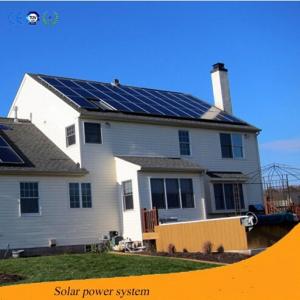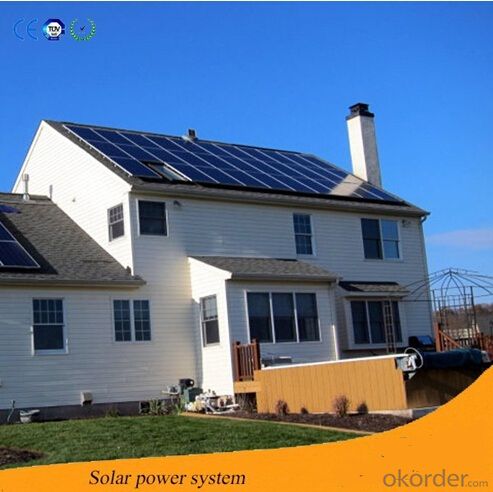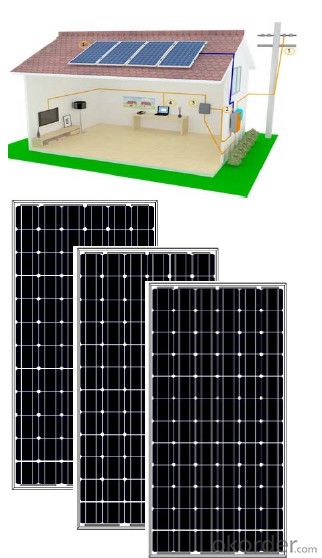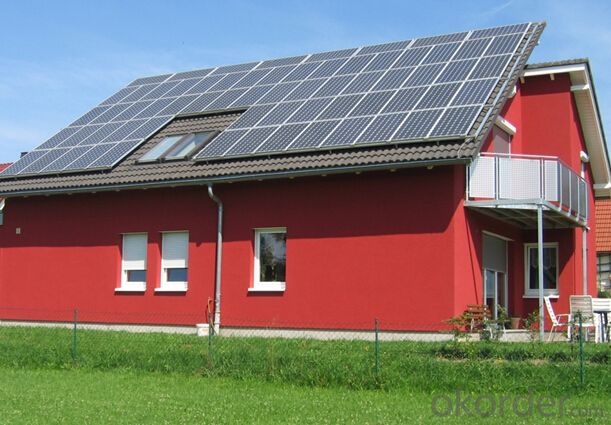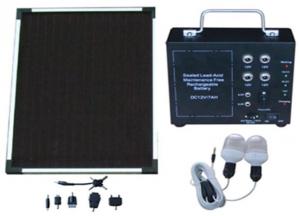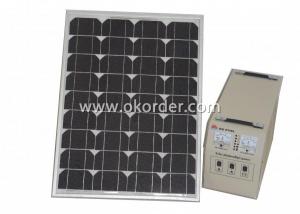Springers Solar Energy Systems Zhenfa-AC1.68KW Solar Home System
- Loading Port:
- China Main Port
- Payment Terms:
- TT OR LC
- Min Order Qty:
- -
- Supply Capability:
- -
OKorder Service Pledge
Quality Product, Order Online Tracking, Timely Delivery
OKorder Financial Service
Credit Rating, Credit Services, Credit Purchasing
You Might Also Like

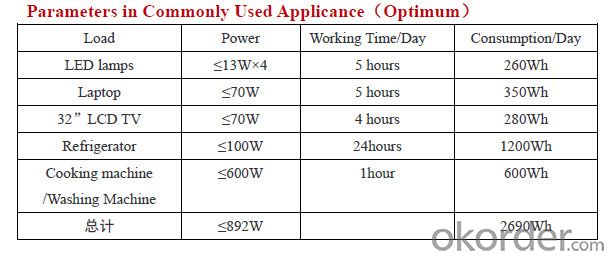

In certain emerging markets, Zhenfa new energy offers home owners complete residential solar system solutions to meet their green energy needs. Zhenfa's residential solar power systems are designed to meet different building applications in system sizes of 1.68kW and 3.9kW. Zhenfa also provides customized solar system solutions for special solar power systemapplications.
- Q: How do I maintain and clean my solar energy system?
- To maintain and clean your solar energy system, there are a few key steps you can follow. Firstly, regularly inspect the solar panels for any signs of damage or debris accumulation. If you notice any issues, it's important to address them promptly. Secondly, keep the panels clean by gently washing them with water and a non-abrasive sponge or cloth. Avoid using harsh chemicals or abrasive materials that could scratch the surface. Additionally, trimming nearby trees or branches that may cast shadows on the panels can help maximize their efficiency. Lastly, consider scheduling professional maintenance and cleaning services every few years to ensure optimal performance and longevity of your solar energy system.
- Q: Are solar energy systems suitable for commercial buildings?
- Yes, solar energy systems are suitable for commercial buildings. They offer numerous benefits such as cost savings on electricity bills, reduced carbon footprint, and potential tax incentives. Additionally, the availability of ample rooftop space in many commercial buildings makes it easier to install solar panels.
- Q: Can solar energy systems be used in remote locations without access to the grid?
- Yes, solar energy systems can be used in remote locations without access to the grid. These systems, commonly known as off-grid solar systems, can generate electricity by harnessing energy from the sun and store it in batteries for use when needed. This makes them a reliable and sustainable solution for powering remote locations where grid connectivity is not available.
- Q: What is the role of energy management systems in a solar energy system?
- Efficiently managing and optimizing solar energy generation, storage, and consumption, energy management systems are crucial in solar energy systems. These systems monitor and control various components, ensuring efficient utilization of energy produced by solar panels. A significant function of energy management systems is to regulate electricity flow between solar panels, energy storage systems, and connected loads. This involves constant monitoring of energy production and consumption levels, allowing adjustments for maximum efficiency. Real-time data and analytics on solar energy system performance are provided by energy management systems. This includes information on energy generation, consumption patterns, and overall system efficiency. By analyzing this data, users can identify areas for improvement and optimize system performance. Remote monitoring and control of solar energy systems are made possible by energy management systems. This allows users to conveniently monitor energy production, consumption, and storage levels from anywhere. It also enables users to remotely adjust settings or control loads during peak energy consumption periods. Furthermore, energy management systems prioritize the use of self-generated energy, maximizing the utilization of solar energy. Excess energy produced by solar panels can be directed towards charging the energy storage system instead of exporting it to the grid. This ensures efficient storage and utilization of solar energy, reducing reliance on the grid and maximizing the benefits. In conclusion, energy management systems are essential components in solar energy systems. They enhance overall performance and efficiency by efficiently managing electricity flow, providing real-time data, and enabling remote monitoring and control. By optimizing energy generation, storage, and consumption, these systems maximize the benefits of solar energy.
- Q: What is the role of tracking systems in solar energy systems?
- The role of tracking systems in solar energy systems is to maximize the efficiency and output of solar panels by allowing them to follow the sun's movement throughout the day. This ensures that the panels are constantly positioned at an optimal angle to receive the maximum amount of sunlight, resulting in increased energy production.
- Q: Can solar energy systems be used in cold storage facilities?
- Yes, solar energy systems can be used in cold storage facilities. Solar panels can generate electricity to power refrigeration systems, maintaining the required temperature for storage. Additionally, solar energy can also be used to power lighting and other electrical equipment in the facility, reducing dependency on traditional energy sources and providing a sustainable solution for cold storage operations.
- Q: Can solar energy systems be used for powering off-grid cabins?
- Yes, solar energy systems can be used for powering off-grid cabins. Solar panels can be installed on the roof or in nearby areas with good sunlight exposure to capture and convert the sun's energy into electricity. This electricity can then be used to power the cabin's lights, appliances, and other electrical needs, providing a sustainable and renewable energy source. Additionally, solar energy systems can often be combined with battery storage to store excess energy for use during nighttime or cloudy days, ensuring a continuous power supply for off-grid living.
- Q: Can solar energy systems be installed in areas with extreme weather conditions?
- Yes, solar energy systems can be installed in areas with extreme weather conditions. However, the performance and durability of the system may vary depending on the specific weather conditions. Proper design, installation, and maintenance can help ensure that solar systems can withstand extreme weather events such as hurricanes, snowstorms, or high winds. Additionally, advancements in solar technology have made it possible to adapt systems to various weather conditions, making solar energy a viable option in areas with extreme weather.
- Q: Can solar energy systems be used in historical or protected buildings?
- Historical or protected buildings can, in fact, utilize solar energy systems, which proves to be a wise and sustainable solution. Although the installation of solar panels on such buildings requires thorough planning and consideration, it is entirely feasible to maintain the architectural integrity and aesthetics while gaining the advantages of renewable energy sources. One strategy for integrating solar energy systems into historical or protected buildings involves the use of seamless solar panels. These panels are specifically designed to blend harmoniously with the building's design and are installed in a manner that does not alter the historical characteristics. This can be accomplished by placing the solar panels on flat roofs, implementing solar tiles, or positioning them on less visible areas of the building, such as the rear or sides. Preserving the structural integrity of the building is another crucial aspect when installing solar energy systems on historical or protected buildings. This can be achieved by utilizing non-penetrating mounting systems that avoid drilling or damaging the building's structure. Additionally, it is essential to consult with architects, engineers, and preservation experts to ensure that the installation process adheres to any preservation guidelines or regulations. By embracing solar energy systems, historical or protected buildings can enhance their sustainability and reduce their carbon footprint. Solar panels offer a clean and renewable source of electricity, thereby reducing reliance on fossil fuels and minimizing greenhouse gas emissions. Furthermore, solar energy systems often generate sufficient power to meet the energy requirements of these buildings, rendering them self-sufficient and potentially enabling them to contribute surplus energy back to the grid. In conclusion, with careful planning and consideration, solar energy systems can undoubtedly be incorporated into historical or protected buildings. By employing integrated solar panels and seeking guidance from preservation experts, it is possible to harness the advantages of renewable energy while preserving the architectural and historical significance of these buildings. This approach not only ensures a sustainable future but also showcases the harmonious coexistence of modern technology and historical preservation.
- Q: Can solar energy systems be used in powering concert halls or auditoriums?
- Yes, solar energy systems can certainly be used to power concert halls or auditoriums. The use of solar energy in large venues like concert halls and auditoriums has become increasingly popular due to its numerous benefits. Solar panels can be installed on the roof or surrounding areas of the venue to capture sunlight and convert it into electricity. This renewable energy source can then be used to power all the electrical equipment and lighting systems within the concert hall or auditorium. One of the main advantages of using solar energy systems in these venues is the potential cost savings. Concert halls and auditoriums often consume large amounts of electricity, particularly during events and performances. By harnessing solar power, these venues can significantly reduce their dependence on the traditional power grid and lower their energy bills. Additionally, solar energy systems require minimal maintenance once installed, which further contributes to the long-term cost-effectiveness. Moreover, integrating solar energy into concert halls and auditoriums aligns with the growing global focus on sustainability and reducing carbon footprints. By utilizing renewable energy sources like solar power, these venues can significantly decrease their greenhouse gas emissions and promote a more environmentally friendly approach to energy consumption. This not only benefits the venue itself but also contributes to the overall sustainability goals of the local community and society as a whole. However, it is important to consider that the size and power requirements of concert halls and auditoriums may require a significant investment in solar panels and associated equipment. The venue's energy demand, the available space for installation, and the local climate are all factors that need to be assessed during the planning stage. It is crucial to ensure that the solar energy system is properly sized to meet the energy needs of the venue and that it is designed to withstand the specific weather conditions of the location. In conclusion, solar energy systems can indeed be used to power concert halls or auditoriums. The benefits of using solar power in these venues include cost savings, environmental sustainability, and reducing reliance on the traditional power grid. With careful planning and installation, solar energy can provide a reliable and efficient source of electricity to meet the energy demands of such large-scale venues.
Send your message to us
Springers Solar Energy Systems Zhenfa-AC1.68KW Solar Home System
- Loading Port:
- China Main Port
- Payment Terms:
- TT OR LC
- Min Order Qty:
- -
- Supply Capability:
- -
OKorder Service Pledge
Quality Product, Order Online Tracking, Timely Delivery
OKorder Financial Service
Credit Rating, Credit Services, Credit Purchasing
Similar products
Hot products
Hot Searches
Related keywords
